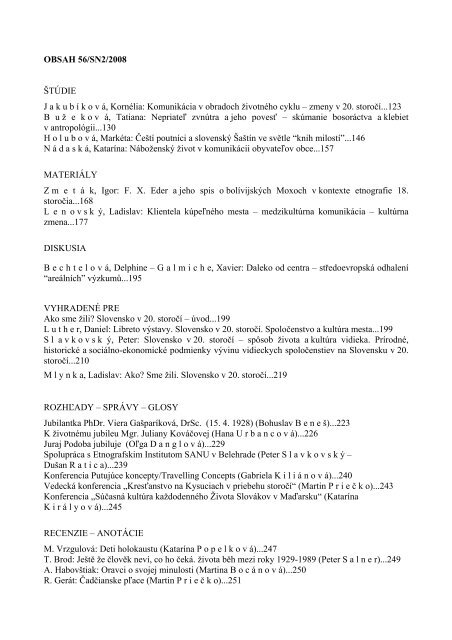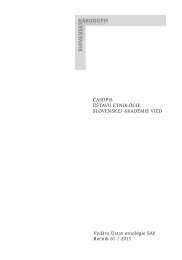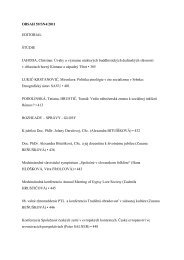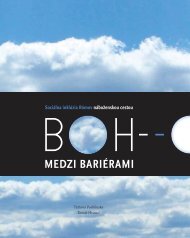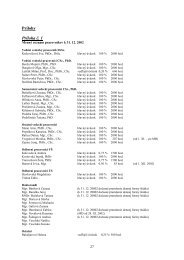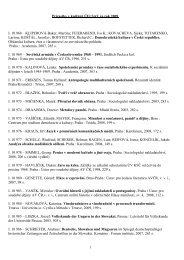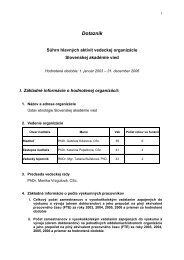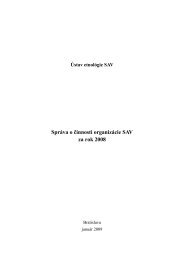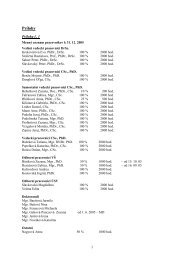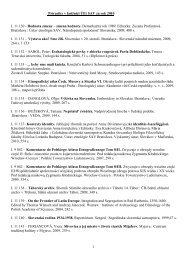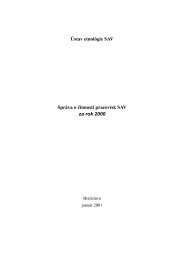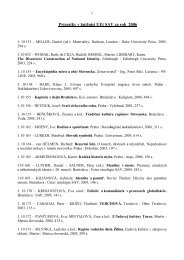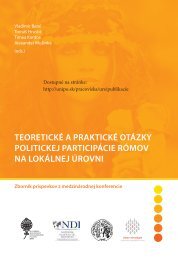OBSAH 56/SN2/2008 Å TÃDIE J akub à kov á, Kornélia: Komunikácia ...
OBSAH 56/SN2/2008 Å TÃDIE J akub à kov á, Kornélia: Komunikácia ...
OBSAH 56/SN2/2008 Å TÃDIE J akub à kov á, Kornélia: Komunikácia ...
Create successful ePaper yourself
Turn your PDF publications into a flip-book with our unique Google optimized e-Paper software.
<strong>OBSAH</strong> <strong>56</strong>/<strong>SN2</strong>/<strong>2008</strong><br />
ŠTÚDIE<br />
J a k u b í k o v á, Kornélia: Komunikácia v obradoch životného cyklu – zmeny v 20. storočí...123<br />
B u ž e k o v á, Tatiana: Nepriateľ zvnútra a jeho povesť – skúmanie bosoráctva a klebiet<br />
v antropológii...130<br />
H o l u b o v á, Markéta: Čeští poutníci a slovenský Šaštín ve světle “knih milostí”...146<br />
N á d a s k á, Katarína: Náboženský život v komunikácii obyvateľov obce...157<br />
MATERIÁLY<br />
Z m e t á k, Igor: F. X. Eder a jeho spis o bolívijských Moxoch v kontexte etnografie 18.<br />
storočia...168<br />
L e n o v s k ý, Ladislav: Klientela kúpeľného mesta – medzikultúrna komunikácia – kultúrna<br />
zmena...177<br />
DISKUSIA<br />
B e c h t e l o v á, Delphine – G a l m i c h e, Xavier: Daleko od centra – středoevropská odhalení<br />
“areálních” výzkumů...195<br />
VYHRADENÉ PRE<br />
Ako sme žili Slovensko v 20. storočí – úvod...199<br />
L u t h e r, Daniel: Libreto výstavy. Slovensko v 20. storočí. Spoločenstvo a kultúra mesta...199<br />
S l a v k o v s k ý, Peter: Slovensko v 20. storočí – spôsob života a kultúra vidieka. Prírodné,<br />
historické a sociálno-ekonomické podmienky vývinu vidieckych spoločenstiev na Slovensku v 20.<br />
storočí...210<br />
M l y n k a, Ladislav: Ako Sme žili. Slovensko v 20. storočí...219<br />
ROZHĽADY – SPRÁVY – GLOSY<br />
Jubilantka PhDr. Viera Gašparí<strong>kov</strong>á, DrSc. (15. 4. 1928) (Bohuslav B e n e š)...223<br />
K životnému jubileu Mgr. Juliany Kováčovej (Hana U r b a n c o v á)...226<br />
Juraj Podoba jubiluje (Oľga D a n g l o v á)...229<br />
Spolupráca s Etnografskim Institutom SANU v Belehrade (Peter S l a v k o v s k ý –<br />
Dušan R a t i c a)...239<br />
Konferencia Putujúce koncepty/Travelling Concepts (Gabriela K i l i á n o v á)...240<br />
Vedecká konferencia „Kresťanstvo na Kysuciach v priebehu storočí“ (Martin P r i e č k o)...243<br />
Konferencia „Súčasná kultúra každodenného Života Slová<strong>kov</strong> v Maďarsku“ (Katarína<br />
K i r á l y o v á)...245<br />
RECENZIE – ANOTÁCIE<br />
M. Vrzgulová: Deti holokaustu (Katarína P o p e l k o v á)...247<br />
T. Brod: Ještě že člověk neví, co ho čeká. života běh mezi roky 1929-1989 (Peter S a l n e r)...249<br />
A. Habovštiak: Oravci o svojej minulosti (Martina B o c á n o v á)...250<br />
R. Gerát: Čadčianske pľace (Martin P r i e č k o)...251
K. Rozália: Hartai gyógyító hagyományok –Tradičné ľudové liečenie v obci Harta (Izabela<br />
D a n t e r o v á)...253<br />
CONTENTS<br />
STUDIES<br />
J a k u b í k o v á, Kornélia:Communication of life-cycle rituals: changes in the 20th century...123<br />
B u ž e k o v á, Tatiana: Enemy within and reputation: investigation of witchcraft and gossip in<br />
anthropology ...130<br />
H o l u b o v á, Markéta: Czech pilgrims and Slovak Šaštín in the light of the „Books of<br />
mercy“...146<br />
N á d a s k á, Katarína:Religious life in village community (partial results of research)...157<br />
MATERIALS<br />
Z m e t á k, Igor: F. X. Eder and his script on Bolivian Moxos in the context of 18th<br />
century ethnography...168<br />
L e n o v s k ý, Ladislav: Clientele of bath-city – intercultural communication and cultural change<br />
...177<br />
DISCUSSION<br />
B e c h t e l o v á, Delphine – G a l m i c h e, Xavier: Far from the centre – Central-European<br />
revelations of „areal“ researches...197<br />
RESERVED FOR<br />
How did we live Slovakia in the 20th century – introduction...199<br />
L u t h e r, Daniel: Libreto of exhibition. Slovakia in the 20th century. Urban community and<br />
culture...199<br />
S l a v k o v s k ý, Peter: Slovakia in the 20th century – Rural culture and habitus of life. Natural,<br />
historical and social-economic conditions...210<br />
M l y n k a, Ladislav: How We lived. Slovakia in the 20th century...219<br />
NEWS – HORIZONS – GLOSSARY<br />
Jubilee of PhDr. Viera Gašparí<strong>kov</strong>á, DrSc. (Bohuslav B e n e š)...223<br />
Jubilee of Mgr. Juliana Kováčováj (Hana U r b a n c o v á)...226<br />
Jubilee of Juraj Podoba (Oľga D a n g l o v á)...229<br />
Cooperation with the Institut of Ethnology SANU in Beograd (Peter S l a v k o v s k ý – Dušan<br />
R a t i c a)...239<br />
Conference „Travelling Concepts“ (Gabriela K i l i á n o v á)...240<br />
Scientific conference „Christianity in Kysuce in the course of centuries“ (Martin P r i e č k o)...243<br />
Conference „Recent culture of everyday-life of Slovaks in Hungary“ (Katarína K i r á l y o v á)...245<br />
BOOKREVIEWS – ANOTATIONS...247
A B S T R A C T S and S U M M A R I E S <strong>SN2</strong>/<strong>2008</strong><br />
COMMUNICATION OF LIFE-CYCLE RITUALS:<br />
CHANGES IN THE 20 TH CENTURY<br />
(KOMUNIKÁCIA V OBRADOCH ŽIVOTNÉHO CYKLU: ZMENY V 20. STOROČÍ)<br />
KORNÉLIA JAKUBÍKOVÁ<br />
doc. PhDr. Kornélia J<strong>akub</strong>í<strong>kov</strong>á, CSc., Katedra etnológie a kultúrnej antropológie FiF<br />
UK, Gondova 2, 818 01 Bratislava<br />
The article is dealing with changes which have occured in types, contents and participants<br />
of communication in life-cycle rituals (childbirth, wedding, funeral).<br />
Kľúčové slová: obrady životného cyklu, komunikácia, zmeny<br />
Key words: life-cycle rituals, communication, changes<br />
Summary<br />
The article presents a analysis of such elements of life-cycle rituals, the dominant function of which is a disclosure<br />
of the particular ritual’s performance and an invitation to participate in it. I focus on the following attributes of<br />
communication processes:<br />
- what type of communication is used (contact/mediated, oral/written)<br />
- what is the content of communication<br />
- who are the participants of communication<br />
- whether any feedback exists and what it is about<br />
Results of a comparison of traditional vs. contemporary style of ritual communication has showed that various types<br />
of mediated technical communication have been expanding. Share of non-verbal elements – symbols has dropped.<br />
Direct participants of a ritual become also expedients of communication and not as previously, when this role was<br />
played by agents. Feedback is now dominated by verbal forms, whereas in the past, reactions were of material or<br />
activity nature (gifts, assistance). Multifunctionality of ritual communication is still valid, but concerning its structure,<br />
aesthetic and prestigious functions tend to dominate. A new function of retrospective documentary has appeared.<br />
ENEMY WITHIN AND REPUTATION: INVESTIGATION OF WITCHCRAFT<br />
AND GOSSIP IN ANTHROPOLOGY<br />
(NEPRIATEĽ ZVNÚTRA A JEHO POVESŤ:<br />
SKÚMANIE BOSORÁCTVA A KLEBIET V ANTROPOLÓGII)<br />
TATIANA BUŽEKOVÁ<br />
RNDr., Mgr. Tatiana Buže<strong>kov</strong>á, PhD., Ústav etnológie SAV,<br />
Klemensova 19, 813 64 Bratislava<br />
The paper is dedicated to the anthropological investigation of witchcraft and gossip. These<br />
two phenomena are interconnected and have been examined by scholars since the early<br />
period of anthropological research. No anthropologist denied that both witchcraft and<br />
gossip have psychological dimension, but it was not easy to deal with them theoretically.<br />
After delineation of the key points of anthropological investigation of witchcraft and gossip
the author introduces the current perspective of evolutionary psychology integrating<br />
principles and results drawn from evolutionary biology, cognitive science, anthropology,<br />
and neuroscience.<br />
Kľúčové slová: bosoráctvo, čarodejníctvo, klebety, antropológia, evo-lučná<br />
psychológia<br />
Key words: witchcraft, sorcery, gossip, anthropology, evolutionary psychology<br />
Summary<br />
The paper is dedicated to the anthropological investigation of witchcraft and gossip. These two phenomena are<br />
interconnected and have been examined by scholars since the early period of anthropological research. In social<br />
sciences witchcraft has been investigated in different disciplines – folkloristics, history and anthropology. Historical<br />
and anthropological approaches have often overlapped and manifested the same key problems. Most anthropological<br />
and historical works has demonstrated the relations between the occurrence of misfortunes in human life and alleged<br />
personal animosities through beliefs in witchcraft, and the setting of those animosities in particular social contexts.<br />
Both historicists and anthropologists emphasized the close connection between witchcraft and gossip that served as a<br />
main channel of transmission of suspicions concerning alleged witches. Anthropological analysis of gossip, on the<br />
other side, oscillated between functionalistic and psychological explanation. Despite the difference between theoretical<br />
approaches, anthropological research has shown the same characteristics of gossip in different cultural settings: I. It<br />
reinforces norms; 2. It is transmitted between members of one group; 3. It centres around people with whom a close<br />
social relationship exists; 4. To be the butt of gossip is an indication of social importance; 5. Gossip is utilised to<br />
forward personal interests. Reputation appeared as a key aspect in gossip as well as in witchcraft suspicions. From<br />
evolutionary point of view, gossip as a manipulation with reputation was a crucial factor in humans’ evolution: it<br />
presented information that had implications for individuals’ fitness-relevant social strategies in the environment of<br />
evolutionary adaptedness. Evolutionary approach therefore takes into account psychological as well as social factors. It<br />
is consistent with ethnographical findings and offers their explanation in terms of human development.<br />
CZECH PILGRIMS AND SLOVAK ŠAŠTÍN IN THE LIGHT OF<br />
THE „BOOKS OF MERCY“<br />
(ČEŠTÍ POUTNÍCI A SLOVENSKÝ ŠAŠTÍN VE SVĚTLE<br />
„KNIH MILOSTÍ“)<br />
MARKÉTA HOLUBOVÁ<br />
PhDr. Markéta Holubová, Ph.D., Etnologický ústav AV ČR, v.v.i.<br />
Na Florenci 3, 110 01 Praha<br />
Based on the excerpts from the sources, it is apparent that the tradition of pilgrimages to<br />
the Šaštín Virgin from the Moravia-Silesian borderland, is still alive lasting more than 275<br />
years almost without interruption even in the politically unfavourable period of the second<br />
half of the 20th century, although there was a significant shift in the mental experience of<br />
miraculous hearings.<br />
Klíčová slova: „Knihy milostí“, poutnictví, kult Panny Marie<br />
Key worlds: „Books of Miracles“, pilgrimage, cult of the Virgin Mary<br />
Summary<br />
The site of pilgrimage was part of the system of creating regional, religious and ethnic awareness. Mutual cultural<br />
and social ties were forged based on the principle of the manifestation of a certain religious act common to all pilgrims<br />
participating in the pilgrimages which were one of the occasions for the gathering of wider local, frequently also<br />
geographically multiregional communities. The foundation for the dense and relatively evenly distributed network of
sites of pilgrimage emerged in the Czech lands during the post-Tridentine period. In accordance with the nature of the<br />
Baroque pilgrimages knowing no boundaries, a great number of pilgrims from the territory of the Czech lands visited<br />
famous sites of pilgrimage within the Austrian Dual State or beyond its borders.<br />
Among the frequently visited Marian sites of pilgrimage was also the town of Šaštín in Slovakia which was a<br />
destination for processions from the Moravian-Silesian territory soon after 1732. One of the motivating incentives for<br />
undertaking pilgrimages was the fact that the pieta of Šaštín’s Seven Sorrows of the Virgin was considered the<br />
Madonna that worked miracles. After all, there is plenty of evidence to support this in the form of manuscripts and<br />
printed miracle books dating back to 1732-1794.<br />
Excerpts from these sources enable us to examine in a specific manner the oldest experiences of Czech worshippers<br />
going on miracles to Slovak Šaštín. Their comparison with the current books of mercy kept at the Šaštín pilgrimage<br />
Basilica of Seven Sorrows has provided us with remarkable comparative material for the study of transformations of<br />
Czech peregrination to Slovakia.<br />
Based on the excerpts from the sources, it is apparent that the tradition of pilgrimages to the Šaštín Virgin from the<br />
Moravia-Silesian borderland, is still alive lasting more than 275 years almost without interruption even in the<br />
politically unfavourable period of the second half of the 20th century, although there was a significant shift in the<br />
mental experience of miraculous hearings.<br />
RELIGIOUS LIFE IN VILLAGE COMMUNITY COMMUNICATION.<br />
(Partial results of research)<br />
(NÁBOŽENSKÝ ŽIVOT V KOMUNIKÁCII OBYVATEĽOV OBCE -<br />
Čiastočné výskumné závery)<br />
KATARÍNA NÁDASKÁ<br />
PhDr. Katarína Nádaská, PhD., Katedra etnológie a kultúrnej<br />
antropológie FF UK, Gondova 2, 818 01 Bratislava<br />
This paper is focused on the communication about religious life in one rural village of<br />
Zahorie region in West part of Slovakia primarily where the traditional and conservative<br />
character of life and religious identity was closely connected with the local identity<br />
perception. The role of communication leaders judging Sunday homily, participation of<br />
people at divine service, their dressing and behavior, etc. was examined here. The manifest<br />
and collective forms of religiosity together with their local bonds were in this village<br />
emphasized.<br />
Kľúčové slová: náboženská komunikácia, náboženská identita, mienkotvorný líder,<br />
náboženský inštitucionalizmus, ľudová religiozita<br />
Key words: religious communication, religious identity, public opinion leader, religious<br />
institutionalism, folk religiosity<br />
Summary<br />
One of the organizing principles of the local community is to follow the rule „do the same as your neighbor is<br />
doing“. Everyone is member of as small- as large-scale groups and he or she also belongs to different own and foreign<br />
groups (family, occupational group, community, nation…).<br />
Social communication is characterized by its referential systems – networks that enable interactions, control, norms<br />
sharing and moral values of each individual. The networks operate as communication canals between individual and<br />
different groups.<br />
The set of statements and attitudes of community related to crucial societal event is described as public opinion<br />
which John Lock understands not as a sum of individual but rather as „dominant” attitudes. Within the local<br />
community to be under examination it was possible to see the public opinion management otherwise controlled by socalled<br />
public opinion leaders.
Although the community has declared the homogeneity from religious point of view on the one hand, the<br />
heterogeneity was from gender and social perspective on the other hand in the village.<br />
Despite of this heterogeneity it is possible to say that community members share modal values, i.e., dominant signs<br />
of respective culture or society.<br />
The village is located/ neighboring nearby capital city and one small town but there still some aspects of<br />
traditionalism, suicentrism, folk religion and rituality are keeping alive. On the other hand the „real and living“ folklore<br />
is appearing to be vanished while urbanization assists to changing face of rural country, traditional conservativism and<br />
patriarchal mentality.


